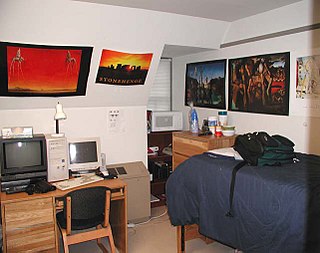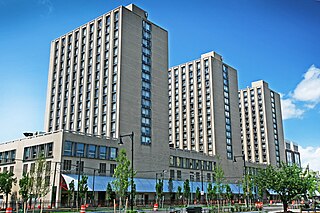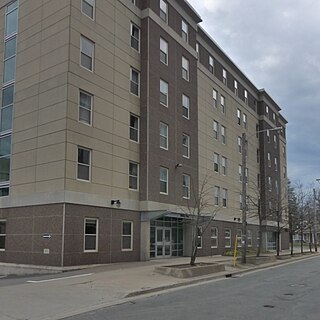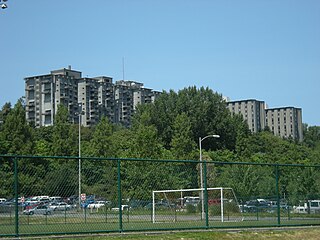
A dormitory, also known as a hall of residence or a residence hall, is a building primarily providing sleeping and residential quarters for large numbers of people such as boarding school, high school, college or university students. In some countries, it can also refer to a room containing several beds accommodating people.

Watterson Towers is a student residence hall at Illinois State University, and is said by the university to be one of the tallest dormitory buildings in the world at 298.5 feet. Located in Normal, Illinois, at the corner of Fell and Beaufort Streets, it was completed in 1969. The 28-story complex holds over 2,200 students and stands at 91m, making it one of the tallest brutalist structures in the world. Watterson Towers was named after Arthur W. Watterson, a popular professor and chair of the ISU Geography Department, who taught at the University from 1946–1966. The building was designed by Fridstein and Fitch Architects in Chicago, and built by C. Iber and Sons Company of Peoria, Illinois.

Warren Towers is one of the three Boston University dormitories traditionally intended for underclassmen, the others being The Towers and West Campus. The building is located at central campus, next to the College of Communication (COM) and across from the College of Arts and Sciences (CAS). Housing approximately 1800 students, it is the second-largest non-military dormitory in the country, behind Jester Center at The University of Texas at Austin. The closest MBTA stop is Boston University East on the Green Line B branch, located directly in front of B and C Towers, in a center reservation on Commonwealth Avenue.

The Boston University housing system is the 2nd-largest of any private university in the United States, with 76% of the undergraduate population living on campus. On-campus housing at BU is an unusually diverse melange, ranging from individual 19th-century brownstone town houses and apartment buildings acquired by the school to large-scale high-rises built in the 60s and 2000s.

North Campus is a mostly residential section of Cornell University's Ithaca, New York, campus, comprising the neighborhoods located north of Fall Creek. All freshmen are housed on North Campus as part of Cornell's common first-year experience and residential initiatives.

Myles Standish Hall is a Boston University dormitory located at 610 Beacon Street, in Kenmore Square. Originally constructed in 1925 and opened as the Myles Standish Hotel, it was deemed to be one of the finest hotels in the world. In 1949 BU acquired the building and converted it into a dormitory.

Saint Francis High School is a Catholic, private college preparatory high school for young men that operates under the administration of Our Lady of the Angels Province of the Order of Friars Minor Conventual in Athol Springs, New York within the Diocese of Buffalo. The school was founded in 1927 by Fr. Justin Figas, OFM Conv. The school is accredited by Middle States Association of Colleges and Schools.

Housing at the Massachusetts Institute of Technology (MIT) consists of eleven undergraduate dormitories and nine graduate dorms. All undergraduate students are required to live in an MIT residence during their first year of study. Undergraduate dorms are usually divided into suites or floors, and usually have Graduate Resident Assistants (GRA), graduate students living among the undergraduates who help support student morale and social activities. Many MIT undergraduate dorms are known for their distinctive student cultures and traditions.

Litchfield Towers, commonly referred to on campus as "Towers", is a complex of residence halls at the University of Pittsburgh's main campus in the Oakland neighborhood of Pittsburgh, Pennsylvania. Litchfield Towers is both the largest and tallest residence hall at the University of Pittsburgh, housing approximately 1,850 students.

Schenley Quadrangle is a cluster of University of Pittsburgh ("Pitt") residence halls that is a Pittsburgh History and Landmarks Foundation Historic Landmark and are contributing properties to the Schenley Farms National Historic District in Pittsburgh, Pennsylvania, United States.

John Risley Hall is a student residence building at Dalhousie University, Halifax, Nova Scotia. Opened in September 2004 after approximately one year of construction, it the newest of Dalhousie's traditional co-ed dormitory-style residences. It is located at 1233 LeMarchant Street at South Street.

Court–Kay–Bauer Community (CKB) is a group of freshman residence halls on Cornell University's North Campus opened to Cornell students in the fall of 2001. The building was first named Court Hall for the dormitory’s formation of a courtyard enclosed on the opposite side by Clara Dickson Hall. On October 14, 2005, the southern wing of Court Hall was renamed Bauer Hall in response to a gift of $10 million to the University by Robert and Virginia Bauer. On October 12, 2006, the middle wing of Court Hall was renamed Kay Hall, also in response to a donation of $10 million by Bill Kay. Court-Kay-Bauer Halls, as well Mews Hall, were built as a part of the North Campus Housing Initiative, and are being renamed in order to fund construction of new upper-classmen residence halls on Cornell’s West Campus. The money generated from the renaming of Court Hall has been put towards the estimated $248 million development of West Campus. Bauer Hall is the section south of the bridge, Kay Hall is the section north of the bridge, and Court Hall is the section perpendicular to Kay Hall.

North Hall was the University of Wisconsin's first building. Built in 1851 in the woods and brush that would become Bascom Hill, this one building was the UW for its first four years, housing both dorm rooms and lecture halls. John Muir resided in North Hall when he was a student at the university from 1860 to 1863.
The McCormick Road Dormitories are one of two main areas of first-year living dormitories at the University of Virginia, the other being the Alderman Road Dormitories. Ten houses make up the residence area located on McCormick Road. The dormitory area was constructed in 1950 and holds nearly 1300 students. Although older and lacking in modern amenities compared to "New Dorms," Old Dorms are closer to Central Grounds and contain larger rooms.

Over 8,000 undergraduate and graduate students live in campus housing at the University of North Carolina at Chapel Hill during a regular school year. Forty residence halls are grouped into 16 residential communities across campus.

Housing at the University of Chicago includes seven residence halls that are divided into 48 houses. Each house has an average of 70 students. Freshmen and sophomores must live on-campus. Limited on-campus housing is available to juniors and seniors. The university operates 28 apartment buildings near campus for graduate students.

Hays Hall was a residence hall at Washington & Jefferson College. The architectural work was performed by Frederick J. Osterling and it was named after President George P. Hays. Construction was completed in 1903 and the new "fireproof" building was opened to Washington & Jefferson Academy students. Rooms were arranged in a suite style, with communal bathrooms on each floor, and shower baths on the 5th floor. In 1912, the Academy closed and Hays Hall was used by Washington & Jefferson College students. At various times, Hays Hall housed the bookstore and a dining hall. By 1968, Hays Hall had deteriorated to the point where it no longer able to house students, but the bookstore remained. In 1982, the building was declared a fire hazard and closed for all uses. While various efforts sought to renovate or restore Hays Hall, including a push to have it named a historical landmark, Hays Hall was demolished in 1994.

The Alderman Road Dormitories are one of two main areas of first-year living dormitories at the University of Virginia, the other being the McCormick Road Dormitories. There were originally eleven houses in the residence area located on Alderman Road, which were constructed in the early 1960s to accommodate a large growth in admitted students. In 2006, the University initiated a replacement project after determining that renovating the dormitories would be less cost effective and would not provide more beds for projected enrolment growth. Additionally, the University wants to provide modern amenities for its first year students. The project, which is split into four phases, were finished by 2015.

Housing at the University of Washington is administered by the Housing & Food Services (HFS) department at the University of Washington. Undergraduates are housed primarily in residence halls located on North Campus and West Campus. Typically, residence halls are 9-month spaces for undergraduate students. However, there are also 12-month apartment spaces available for undergraduate students. Graduate and professional students are provided the option to live in 12-month apartments operated either by the university or privately. The University of Washington does not require students to live on campus. Although students are not required, about 71% of freshmen choose to live on campus. Housing is not guaranteed but placement in the residence halls is guaranteed for returning residents. Most winter quarter and spring quarter applicants are assigned housing. There are also three family housing options for registered full-time students at the Seattle campus.





















